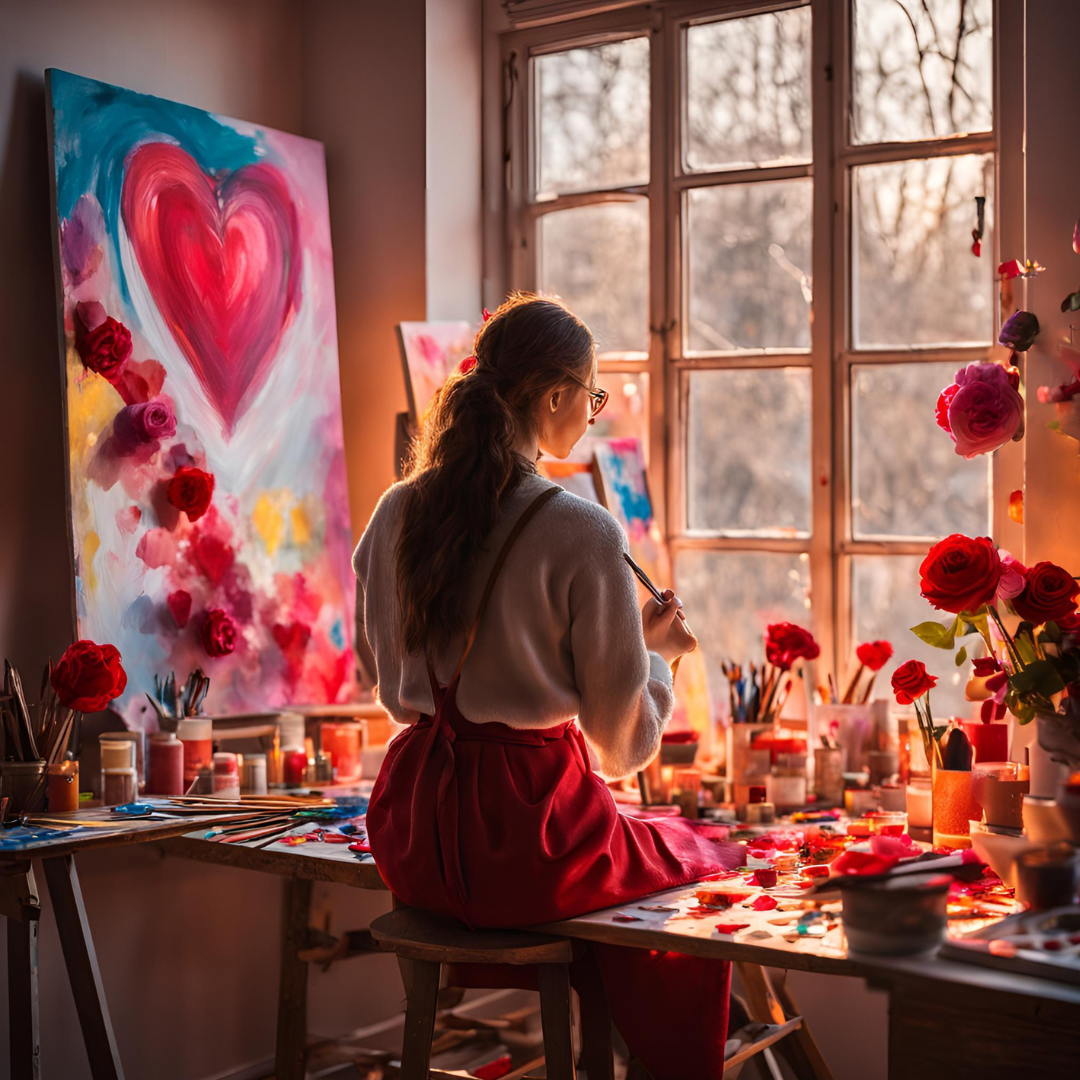
Symbols of love in art through the ages
Love, this mysterious and universal force, has always fascinated artists. It crosses the ages, reinvents itself over the course of eras and sensibilities, connecting us in a common, timeless and infinitely powerful emotion. From ancient frescoes to contemporary creations, art has captured its thousand facets: ardent passion, infinite tenderness, insatiable desire and spiritual love.
Let's dive together into this visual and emotional legacy, and discover how Horizon World Art perpetuates this tradition by reinterpreting love in a new, vibrant and modern light.
Antiquity & Middle Ages: love between myths and nobility of heart
Love in ancient times is often depicted as a tribute to the gods, an irresistible force guided by deities such as Aphrodite and Cupid. Artists of this era depicted love in the form of powerful myths . Aphrodite, the goddess of beauty, is the symbol of pure passion, while Cupid embodies the messenger of human desires. In ancient frescoes, love is often depicted as a divine and captivating force , creating a connection between humans and the gods. Scenes such as the Judgement of Paris , where the apple symbolizes the choice of love, are visual testaments to the power of love in Greek mythology .
The Middle Ages, for their part, represented it in the form of a chivalrous ideal, where courtly love dominated. The troubadours sang the nobility of the heart, and illuminations, stained glass windows and tapestries highlighted a sacralized vision of love. This love was associated with fidelity, devotion and purity, often interpreted through metaphorical visual codes , such as the dove of peace and the rose of sacrifice. Artists of the time conceived love not only as a human feeling, but also as an act of faith, linked to the idea of transcendence and spiritual purity.
Renaissance & Baroque: exalted love, between passion and splendor
The Renaissance, a period of rediscovery of humanism, allowed for a more realistic and intimate representation of love . Artists sought to translate the intensity of the emotion of love in works that mixed symbolism and humanism. Love, in this period, is often represented as a deep and sincere feeling, where flowers and nature are metaphors for passion and desire.
The Baroque, with its dramatic and dynamic style, represented love as a devouring and tumultuous force . Artists, influenced by the social and religious upheavals of the time, played with shadows and lights to accentuate the intensity of emotions. Love in the Baroque is an uncontrollable fire, symbolized by theatrical scenes where passion takes over reason. Here, love is represented both as a sensual fusion and a quest for spiritual redemption.
From Romanticism to the Modern Age: Hearts Unveiled
Romanticism, in the 19th century, focused on the inner torments of the human soul . Love becomes an absolute emotional quest, often tinged with melancholy and nostalgia . Artists represented love in the form of unattainable dreams, often with misty landscapes that reflect the suffering and intensity of romantic feelings. Romantic art deeply explores the notions of passion and romantic pain, seeking to translate the interiority of souls in search of an idealized love.
With modern art, love frees itself from traditional forms and fixed symbols . The artist expresses love in a freer and more subjective way, disconnected from classical forms. Abstract shapes and vibrant colors become means of expression that translate the intensity of the feeling of love in a more personal approach, breaking the boundaries between the artist and the viewer. Love becomes a raw emotion, a silent cry carried by the energy of form and color.
In this context, Roses 1 and Winter Dreams perfectly embody this duality.
- Discover the timelessness and classic beauty of Roses , a universal symbol of love, passion and eternal beauty.

This work reimagines passion in the form of vibrant textures, evoking both the strength and delicacy of love, and capturing the intensity of amorous desire in all its transience. The density of the flowers translates the intensity of the feelings, while their fusion with the dark background evokes the depth and mystery of love, both flamboyant and elusive. The expressive texture reinforces this vivid emotion, where each brushstroke reflects its strength and fragility.
- Dive into a world of dreams and serenity with Winter Dreams , a captivating work that evokes the sweetness and tranquility of winter love.

On the other hand, the work Winter Dreams , with its icy and dreamlike nuances, immerses us in a world of reverie, where love becomes a sweet and inaccessible quest, an emotion suspended in time. This work illustrates a love marked by sweetness and escape, where sleep symbolizes abandonment and trust. The soothing hues and enveloping drapes suggest an invisible embrace, an emotional bond that is both intimate and ethereal, like a feeling that exists between dream and reality.
Love in Contemporary Art: An Infinite Declaration
In contemporary art, love is approached from multiple angles, each reflecting the complexity of human emotions . Love is less a fixed ideal than a subjective, raw, visceral experience, an emotion in constant evolution, imbued with personal nuances.
Contemporary artists reinterpret traditional symbols of love, while anchoring them in a world in perpetual motion. Love here becomes an inner exploration, a means of free expression, far from the conventions of the past. The works express pure, but also conflicting feelings, representing love as a quest, an ascension or an endless desire.
It is in this dynamic that Vers la Lumière and Assoiffée d’Amour find their place.
- Be inspired by hope and light with Towards the Light , an original work that symbolizes the love that guides towards a bright future.

Towards the Light symbolizes love as a path to spiritual and personal elevation, a quest for fulfillment and transcendence. It translates love as an ascension, an ideal of unity and light. The butterfly, ephemeral and free, symbolizes an elusive love, while the flower, rooted and vibrant, represents constancy and the desire for union. The cloudy background adds a touch of mystery, suggesting a love that is both intense and fleeting, always in balance between the ephemeral and the eternal.
- Let yourself be transported by the intensity of romantic desire with Assoifée d'Amour , an original work that transcends words and expresses raw passion.

In contrast, Assoiffée d’Amour explores the visceral intensity of desire. This work immerses the viewer in the raw and inescapable force of emotion, capturing the primal energy of love in its most intense and pure state. Love is illustrated through an intimate embrace, a symbol of connection and tenderness. The warm tones evoke the warmth of feelings, while the fusion of silhouettes translates a deep connection. The red dress reinforces the passion and emotional intensity.
Art as the eternal messenger of love
Throughout the ages, love remains a timeless theme, represented in a thousand forms, from the most divine to the most human. The artists of Horizon World Art , by reinterpreting these symbols in the light of modernity, continue this dialogue between past and present. Art thus becomes a vehicle of universal communication, capable of transmitting the intensity of love in all its nuances.
Each work , whether a painting, a sculpture or a contemporary installation, embodies the essence of love : an elusive, yet universal feeling, which is lived and felt through art. Through this gallery, we are invited to experience an endless love, a love that transcends time and borders.
